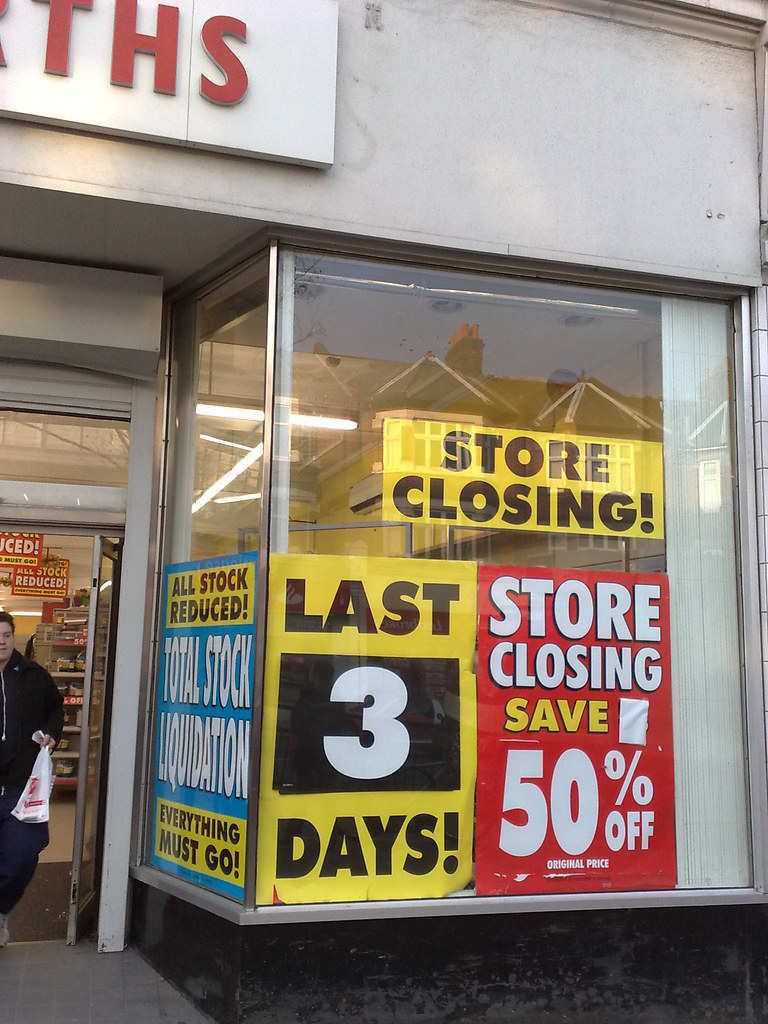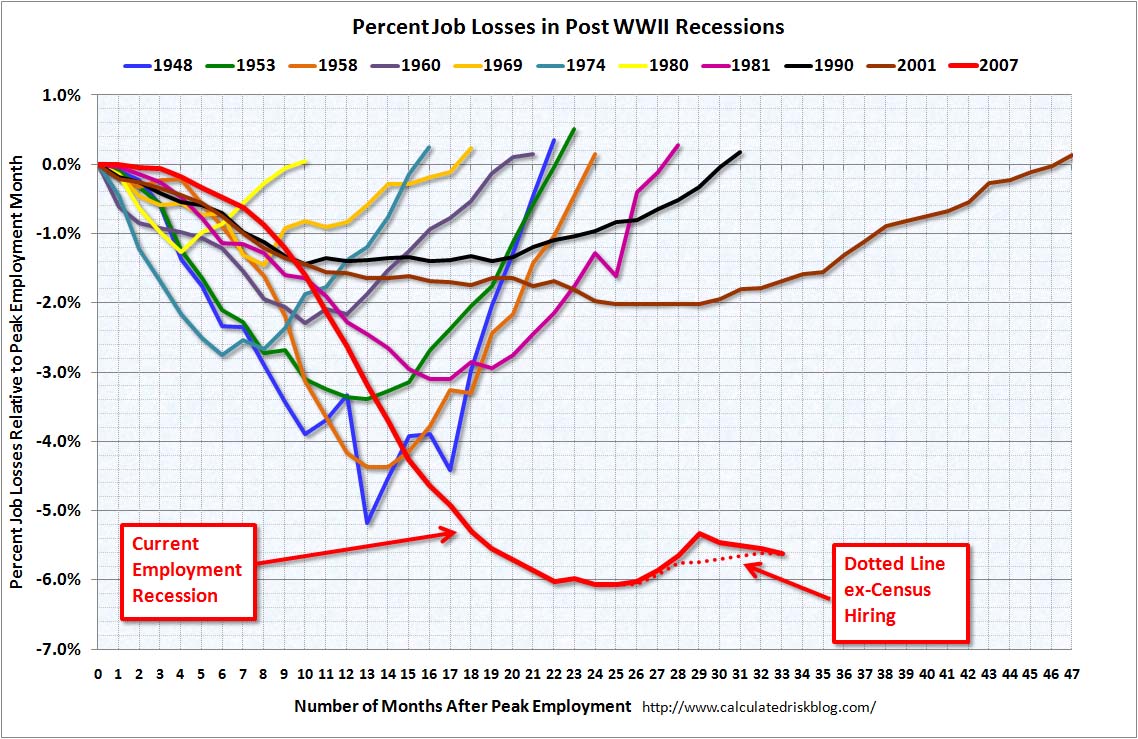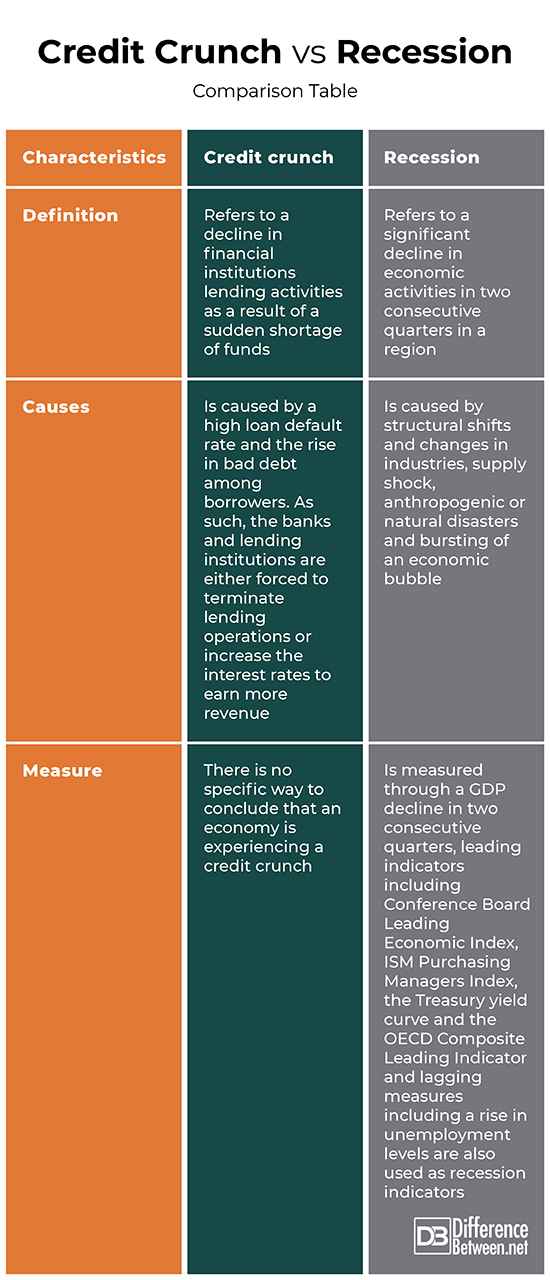Difference Between Credit Crunch and Recession
Economic growth is impacted by various factors including human resources, natural resources, capital formation, technological development, and social and political factors. Sustaining a positive growth in an economy leads to an increase in the national income, employment levels hence higher living standards. While this should be the norm, factors such as loss of consumer confidence in the economy, the rise in asset prices, falling wages, depreciation in the value of exchange rate as well as lower interest rates negatively affect the economies, resulting in recessions and credit crunches.

What does Credit Crunch mean?
Also referred to as credit crisis or credit squeeze, this is a decline in financial institutions lending activities as a result of a sudden shortage of funds. This results in the lack of confidence from the lenders which in turn results to an increase in interest rates which makes it impossible for companies to borrow.
A credit crunch often occurs as an extension of a recession, an effect that is felt throughout the economy. The inability to acquire funds that could be used to finance operations or expand business operations often forces them to close down or cut down their operations.
Other possible causes of a credit crunch include:
- Increase in interest rates
- Lack of funds in the capital markets
- Controls of money by the government
Credit crunches are caused by a high loan default rate and the rise in bad debt among borrowers. As such, the banks and lending institutions are either forced to terminate lending operations or increase the interest rates to earn more revenue.
The result of this shrinking credit supply leads to a slower recovery hence a prolonged recession characterized by the decline in productivity and an increase in unemployment.

What is Recession?
This is a significant decline in economic activities in two consecutive quarters in a region. Measured by a decline in real GDP, a recession is spread throughout the economy and is visible in employment, real income, wholesale-retail sales and industrial production.
Although unpleasant, recessions are part of the business cycle.
Recessions are characterized by:
- Business failures
- High levels of unemployment
- Bank failures
- Negative growth in production
In the event of a recession, investors are encouraged to invest in companies with strong balance sheets, low debt and good cash flow. Speculative, highly leveraged and cyclical companies should be avoided.
Although recessions cannot be predicted, economics access various metrics to determine when a recession is likely to occur. The GDP decline in two consecutive quarters is the most common indicator followed leading indicators including Conference Board Leading Economic Index, ISM Purchasing Managers Index, the Treasury yield curve and the OECD Composite Leading Indicator. Lagging measures including a rise in unemployment levels are also used as recession indicators.
Examples of causes of recessions include:
- Structural shifts and changes in industries
- Supply shock
- Anthropogenic or natural disasters
- Bursting of an economic bubble
Similarities between Credit crunch and Recession
- Both have negative effects on economies
Differences between Credit crunch and Recession
Definition
Credit crunch refers to a decline in financial institutions lending activities as a result of a sudden shortage of funds. On the other hand, recession refers to a significant decline in economic activities in two consecutive quarters in a region.
Causes
A credit crunch is caused by a high loan default rate and the rise in bad debt among borrowers. As such, the banks and lending institutions are either forced to terminate lending operations or increase the interest rates to earn more revenue. On the other hand, a recession is caused by structural shifts and changes in industries, supply shock, anthropogenic or natural disasters and bursting of an economic bubble.
Measure
While there is no specific way to conclude that an economy is experiencing a credit crunch, a recession is measured through a GDP decline in two consecutive quarters, leading indicators including Conference Board Leading Economic Index, ISM Purchasing Managers Index, the Treasury yield curve and the OECD Composite Leading Indicator and lagging measures including a rise in unemployment levels are also used as recession indicators.
Credit crunch vs. Recession: Comparison Table

Summary Credit crunch vs. Recession
Credit crunch refers to a decline in financial institutions lending activities as a result of a sudden shortage of funds. It is caused by a high loan default rate and the rise in bad debt among borrowers. As such, the banks and lending institutions are either forced to terminate lending operations or increase the interest rates to earn more revenue.
On the other hand, recession refers to a significant decline in economic activities in two consecutive quarters in a region. It is caused by structural shifts and changes in industries, supply shock, anthropogenic or natural disasters and bursting of an economic bubble.
Both, however, have negative effects on economies.
- Difference Between Profit Center and Investment Center - July 2, 2022
- Difference Between Anti-Trust and Anti-Competition - June 6, 2022
- Difference Between Stocktaking and Stock Control - June 6, 2022
Search DifferenceBetween.net :
Leave a Response
References :
[0]Malavasi R & Rossi S. Financial Crisis, Bank Behaviour and Credit Crunch. Springer Publishers, 2015. https://books.google.co.ke/books?id=s9VJCgAAQBAJ&pg=PA11&dq=Difference+between+credit+crunch+and+recession&hl=en&sa=X&ved=2ahUKEwiCvpP-_cDqAhUGxYUKHY_ZCncQ6AEwAXoECAYQAg#v=onepage&q=Difference%20between%20credit%20crunch%20and%20recession&f=false
[1]David Murphy. Unravelling the Credit Crunch. CRC Press, 2009. https://books.google.co.ke/books?id=FMPE_PHRaIwC&pg=PT43&dq=Difference+between+credit+crunch+and+recession&hl=en&sa=X&ved=2ahUKEwiCvpP-_cDqAhUGxYUKHY_ZCncQ6AEwBHoECAIQAg#v=onepage&q=Difference%20between%20credit%20crunch%20and%20recession&f=false
[2]Michael Roberts. The Great Recession. Lulu.com, 2009. https://books.google.co.ke/books?id=8KjMAgAAQBAJ&printsec=frontcover&dq=Difference+between+credit+crunch+and+recession&hl=en&sa=X&ved=2ahUKEwiCvpP-_cDqAhUGxYUKHY_ZCncQ6AEwAHoECAMQAg#v=onepage&q=Difference%20between%20credit%20crunch%20and%20recession&f=false
[3]Image credit: https://upload.wikimedia.org/wikipedia/commons/7/7d/Percent_Job_Losses_After_WWII_Recessions.jpg
[4]Image credit: https://live.staticflickr.com/3293/3142448084_5f5ae36a93_b.jpg
